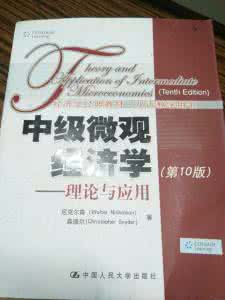Syllabus for Microeconomics The Nature of the Course:Specialized required course
Suitable Specialty: International economy and trade Marketing Accounting Information Management and Systems Business Administration Financial Administration
Credit: 4
Class Hours:64
Authors: yijun liu ling lang
The Purpose and Tasks of the Course
This course is a basic professional course for undergraduate in the School of Business and Management. Through this course, students have a more comprehensive understanding of basic issues and basic viewpoints on the microeconomics. They can grasp the basic concepts of microeconomics, the basic idea, the basic analytical methods and basic theory as well. More important, lay ing a theoretical foundation for the further study of other professional courses.
The Basic Requirements of the Course
1.Require students to grasp the basic concept, the basic thought, the basic analysis method and the elementary theory of microeconomics.
2.Require students to conduct self-study, and students are encouraged to widely read reference books to make it more understanding of basic economic theory and its application in all respects.
3.Require teachers to pay close attention to using graphic tools and using mathematical tools properly.
4.The advance curriculum is the higher mathematics.
Outline the Content and Hours Allocation Recommendations
Chapter 1 Introduction 6 Class Hours §1 Ten Principles of Economics
1.How People Make Decisions
2. How People Interact
3.How the Economy as a Whole Works
§2 Thinking Like an Economist
1.The Economist as a Scientist
2. The Economist as a Policy Adviser
3.Why Economist Disagree
§3 the Using of Graphs in Economics (#)
1. Graphic Drawing and Graphics Type in Economic Analysis
1
2.Slope and Elasticity
3. Note for Graphics Use in Economic Analysis
§4 Interdependence and the Gains from Trade
1.The Production Possibilities Frontier、Specialization and Trade
2.Comparative Advantage
3.Applications of Comparative Advantage
Chapter 2 Supply and Demand(Ⅰ):How Markets Work 8 Class Hours
§1 Markets and Competition
1.Competitive Market
2.Other Markets
§2 law of demand
1. Demand and the Demand Curve
2. Shifts in the Demand Curve and Shift of the Demand Curve
3. Market Demand and Individual Demand
§3 law of supply (#)
1. Supply and the Supply Curve
2. Shifts in the Supply Curve and Shift of the Supply Curve
3. Market Supply and Individual Supply
§4 Supply and Demand Model
1.The Conditions of Supply and Demand Model
2.Supply and Demand Model
3.What happens to equilibrium when supply and demand shifts?
4.Cobweb Theory (☆)
§5 Elasticity and The Applications of Elasticity Theory
1. the Elasticity of Demand and Its Application
2. the Elasticity of Supply and Its Application (#)
§6 Supply、Demand and Government Policies
1.Controls on prices (#)
2.How Taxes Affect Market Outcomes
3.Can Good News for Farming Be Bad News for Farmers?
Exercise classes 2 Class Hours Chapter 3 Supply and Demand(Ⅱ):Market and Welfare 16 Class Hours §1 The Theory of Consumer Choice 4 Class Hours
1.Cardinal Utility Theory
2. Preference Theory
3.Application of The Theory of Consumer Choice
§2 The Theory of Producer Choice 6 Class Hours
1. The Organization of Production (#)
2. Production Function and Factor Inputs
3. The Cost Theory
§3 Consumer Surplus 2 Class Hours
1.Willingness to Pay
2.Using the Demand Curve to Measure Consumer Surplus
3.How a Lower Price Raises Consumer Surplus
§4 Producer Surplus (#)
1.Cost and the Willingness to Sell
2
2. Using the Supply Curve to Measure Producer Surplus
3. How a Higher Price Raises Producer Surplus
§5 Market Efficiency 2 Class Hours
1.The Concept of Efficiency
2.The Equilibrium Efficiency of the Competitive Firm(1)
3.The conditions of the Efficient Competitive Firm
§6 Application:The Cost of Taxation 2 Class Hours
1.The Deadweight Loss of Taxation
2.The Determinants of the Deadweight Loss
3. Deadweight Loss and Tax Revenue as Taxes Vary
§7 Application:International Trade (#)
1.The Determinants of Trade
2.The Winners and Losers from Trade
3.The Arguments for Restricting Trade
Exercise classes 3 Class Hours Discussion class 1 Class Hour
Chapter 4 The Economics of the Public Sector 4 Class Hours
§1 Externalities
1.Externalities and Market Inefficiency
2.Private Solutions to Externalities
3.Public Policies toward Externalities
§2 Public Goods and Common Resources
1.The Different Kinds of Goods
2.Public Goods
3.Common Resources
§3 The Design of the Tax System(#)
1. Taxes and Efficiency
2. Taxes and Equity
Chapter 5 Supply and Demand(Ⅲ):Enterprise behavior and industrial organization 8 Class Hours
§1 Types of Market (#)
§2 Firms in Competitive Markets 4 Class Hours
1. The Demand Curve and Revenue Curve of the Competitive Firm
2. The Short-run Decision and the Supply Curve of the Competitive Firm
3. The Short-run Supply Curve of the Competitive Market
4.The Competitive Firm's Long-run Decision
5.The Long-run Supply Curve of the Competitive Firm
6.The Equilibrium Efficiency of the Competitive Firm(2)
§3 Monopoly 4 Class Hours
1.Why Monopolies Arise
2.The Demand Curve and Revenue Curve of the Monopolistic Firm
3.The Monopolistic Firm's Short-run and Long-run Decision
4.The Welfare Cost of Monopoly
5.Public Policy toward Monopolies
6.Price Discrimination
§4 Oligopoly (#)
3
1. Markets with Only a few Sellers
2. Game Theory and the Economics of Cooperation
3. Public Policy toward Oligopolies
§5 Monopolistic Competition (#)
1.The Demand Curve and Revenue Curve of The Monopolistic
Competitive Firm
2. The Monopolistic Competitive Firm in the Short-run and Long-run
3. Monopolistic Competition and the Welfare of Society
4. Advertising
Exercise classes 1 Class Hour Discussion class 1 Class Hour
Chapter 6 Supply and Demand(Ⅳ):The Markets for the factors of production
6 Class Hours
§1 How Markets Determine Incomes
1. Income and Wealth (#)
2. Marginal Productivity Determines the Prices of Inputs
§2 The Economics of Labor Market
1.The Demand and Supply for Labor (#)
2.Equilibrium in the Labor Market (#)
3. Some Determinants of Equilibrium Wages
4.The Economics of Discrimination
§3 The Land Market and The Capital Market
1.Land and Rent
2.Capital and Interest
§4 Income Distribution (#)
1.The Measurement of Inequality
2.The Political Philosophy of Redistributing Income
3.Policies to Reduce Poverty
Discussion class 2 Class Hours
Chapter 7 Supply and Demand(Ⅴ):(General equilibrium) Market and Welfare (☆)
§1 General equilibrium
1.Meaning of the Equilibrium
2. The Equilibrium Model of Léon Walras
3. The Two-sector Model of General Equilibrium
§2 Welfare Economics
1.The Social Welfare Function
2.Equity and Efficiency

Chapter 8 Uncertainty and Information (☆)
§1 Uncertainty in the Economy
1. Uncertainties and Risks
2. The Effectiveness of Property
3. Measurement of Risk Cost
§2 Information, Risk and Markets
1. Insurance and Risk-sharing
2. Private Information and Market
3. Risk Management in the Financial Markets
4
Review class 2 Class Hours Flexible time 4 Class Hours
note:(#) Expressed that students learn these contents on its own, and they are
included in the scope of examination.
(☆)Expressed that students can choose according to their interest in reading,
but not included in the scope of examination.
Recommended Teaching Materials and Major Reference Books
1.[美]曼昆著,梁小民译,《经济学原理(第5版)》,机械工业出版社,2009
年
2.[美]保罗·萨缪尔森、威廉·诺德豪斯著,萧琛主译,《经济学(第18版)》,
人民邮电出版社,2008年
3.刘毅军主编,《经济学基础》,石油工业出版社,2006年
4.[美]平狄克、鲁宾费尔德著,王世磊等译,《微观经济学(第7版)》,中国人民大学出版社,2009年
 爱华网
爱华网



